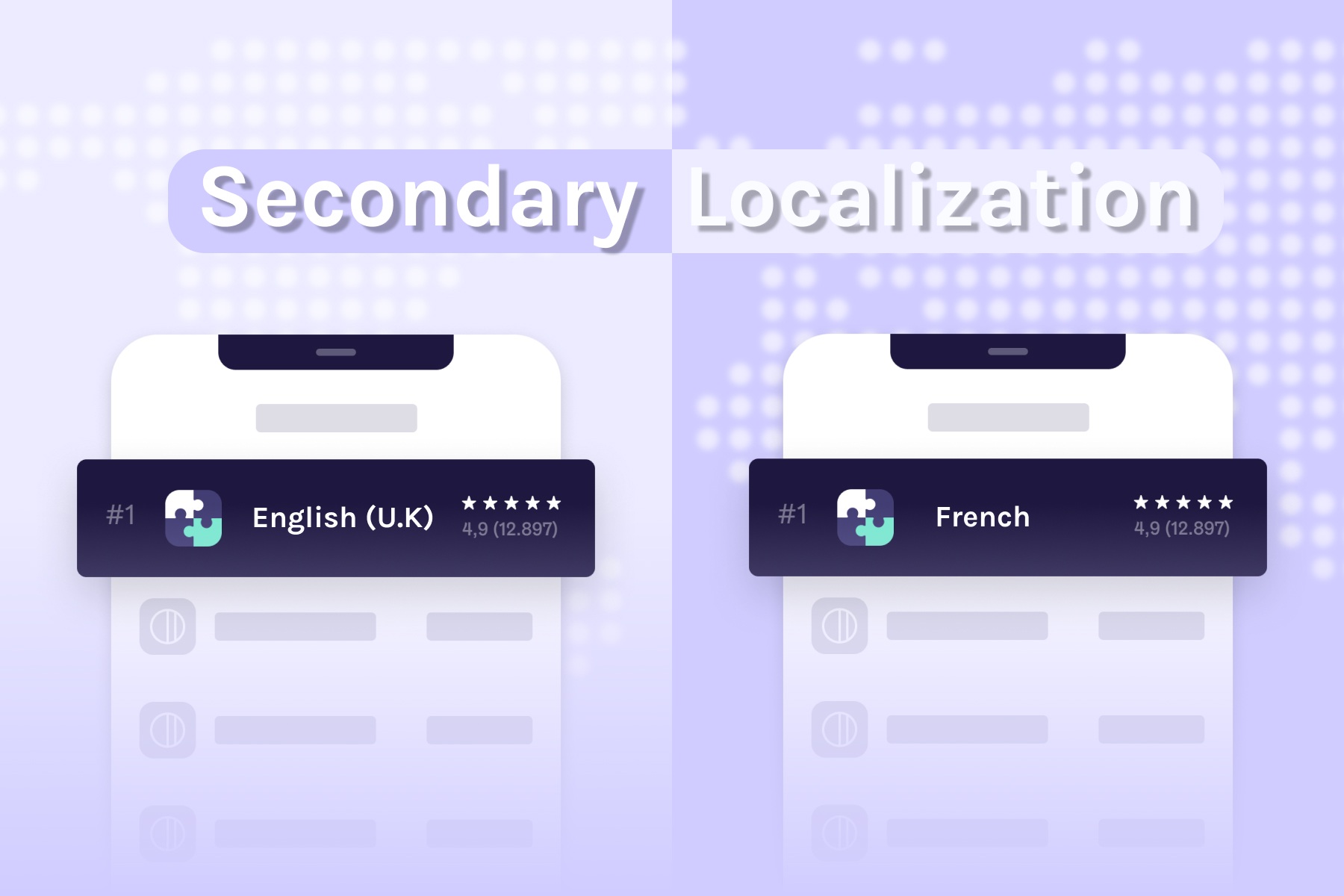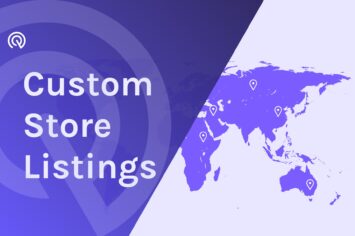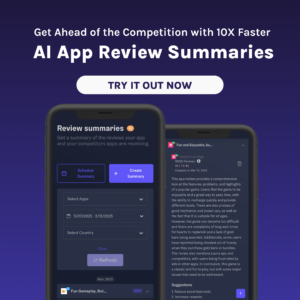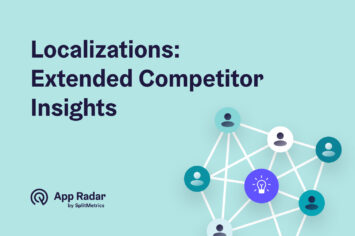iOS Localization: primary language and secondary localization
App localization is an important factor in app growth. Although Apple App Store is a mystery box for a lot of app marketers, there are still some proven tactics that help to increase app visibility. One of them is using a keyword field with no spaces, no duplicates, most important keywords in the title or subtitle. In this article, we uncover another important ASO approach - secondary localization for Apple App Store. By the end of this article, you will have an overview of the main and additional languages in 155 countries. And learn one of the most used tricks with secondary localization that can help you increase your keyword indexation rate.

What is iOS primary language and secondary localization?
When launching an app in App Store Connect, you need to choose the app’s primary (or default) language. Primary language is the main language of the app. For all locals where you do not offer a localized version of your store listing, the App Store will automatically show your primary language. It is absolutely up to you which language you choose as a primary one. However, keep in mind that your app metadata will be shown in your primary language to all users in the locations which you didn’t localize. In other words, if your primary language is Chinese and you didn’t localize your app with English as a secondary language, all users with English set phones will see your app’s metadata in Chinese (by default). Therefore, consider your main target audience and choose your primary language wisely.

Secondary localization gives you an opportunity to add multiple languages in order to increase audience reach. Depending on your growth strategy, you can select additional languages that will help you to reach a specific audience. For instance, if your primary language in Spain is Spanish, it will make sense to add Catalan and English (U.K.) as the secondary languages. In this case, you're still targeting the Spanish-speaking market but extending the reach to Catalan and English-speaking users.

Interested in growing your app in different markets? Learn how to localize your app and reach a global audience.
Full list of main and secondary localizations for iOS
Before you add a second language to your app, make sure you target the right speaking audience. As was mentioned before, it is up to your overall app strategy which languages to choose as primary and secondary. But here is a full list of 155 countries with main and additional localization languages that will help you to understand specific market language preferences.
North America
| COUNTRY | MAIN LANGUAGE | ADDITIONAL LANGUAGES |
|---|---|---|
| Canada | English (Canada) | French (Canada) |
| United States | English (U.S.) | Spanish (Mexico), Russian, Chinese (Simplified), Arabic, French, Portuguese (Brazil), Chinese (Traditional), Vietnamese, Korean |
Europe
| COUNTRY | MAIN LANGUAGE | ADDITIONAL LANGUAGES |
|---|---|---|
| Albania | English (U.K.) | |
| Austria | German | English (U.K.) |
| Belarus | English (U.K.) | |
| Belgium | English (U.K.) | French, Dutch |
| Bulgaria | English (U.K.) | |
| Croatia | Croatian | English (U.K.) |
| Cyprus | English (U.K.) | Greek, Turkish |
| Czech Republic | Czech | English (U.K.) |
| Denmark | English (U.K.) | Danish |
| Estonia | English (U.K.) | |
| Finland | English (U.K.) | Finnish |
| France | French | English (U.K.) |
| Germany | German | English (U.K.) |
| Greece | Greek | English (U.K.) |
| Hungary | Hungarian | English (U.K.) |
| Iceland | English (U.K.) | |
| Ireland | English (U.K.) | |
| Italy | Italian | English (U.K.) |
| Latvia | English (U.K.) | |
| Lithuania | English (U.K.) | |
| Luxembourg | English (U.K.) | French, German |
| Malta | English (U.K.) | |
| Moldova | English (U.K.) | |
| Netherlands | Dutch | English (U.K.) |
| North Macedonia | English (U.K.) | |
| Norway | Norwegian | English (U.K.) |
| Poland | Polish | English (U.K.) |
| Portugal | Portuguese (Portugal) | English (U.K.) |
| Romania | Romanian | English (U.K.) |
| Russia | Russian | English (U.K.), Ukrainian |
| Slovakia | Slovak | English (U.K.) |
| Slovenia | English (U.K.) | |
| Spain | Spanish (Spain) | English (U.K.), Catalan |
| Sweden | Swedish | English (U.K.) |
| Switzerland | German | English (U.K.), French, Italian |
| Turkey | Turkish | English (U.K.), French |
| Ukraine | Ukrainian | Russian, English (U.K.) |
| United Kingdom | English (U.K.) |
Africa, Middle East, and India
| COUNTRY | MAIN LANGUAGE | ADDITIONAL LANGUAGES |
|---|---|---|
| Algeria | Arabic | French, English (U.K.) |
| Angola | English (U.K.) | |
| Armenia | English (U.K.) | |
| Azerbaijan | English (U.K.) | |
| Bahrain | Arabic | English (U.K.) |
| Benin | English (U.K.) | French |
| Botswana | English (U.K.) | |
| Burkina Faso | English (U.K.) | French |
| Cape Verde | English (U.K.) | |
| Chad | English (U.K.) | French, Arabic |
| Republic of the Congo | English (U.K.) | French |
| Egypt | Arabic | French, English (U.K.) |
| Gambia | English (U.K.) | |
| Ghana | English (U.K.) | |
| Guinea-Bissau | English (U.K.) | French |
| India | Hindi | English (U.K.) |
| Israel | Hebrew | English (U.K.) |
| Jordan | Arabic | English (U.K.) |
| Kenya | English (U.K.) | |
| Kuwait | Arabic | English (U.K.) |
| Lebanon | Arabic | French, English (U.K.) |
| Liberia | English (U.K.) | |
| Madagascar | English (U.K.) | French |
| Malawi | English (U.K.) | |
| Mali | English (U.K.) | French |
| Mauritania | Arabic | French, English (U.K.) |
| Mauritius | English (U.K.) | French |
| Mozambique | English (U.K.) | |
| Namibia | English (U.K.) | |
| Niger | English (U.K.) | French |
| Nigeria | English (U.K.) | |
| Oman | English (U.K.) | |
| Qatar | English (U.K.) | |
| Saudi Arabia | Arabic | English (U.K.) |
| Senegal | English (U.K.) | French |
| Seychelles | English (U.K.) | French |
| Sierra Leone | English (U.K.) | |
| South Africa | English (U.K.) | |
| Swaziland | English (U.K.) | |
| São Tomé and Príncipe | English (U.K.) | |
| United Republic Of Tanzania, | English (U.K.) | |
| Tunisia | Arabic | French, English (U.K.) |
| Uganda | English (U.K.) | |
| United Arab Emirates | Arabic | English (U.K.) |
| Yemen | Arabic | English (U.K.) |
| Zimbabwe | English (U.K.) |
Asia Pacific
| COUNTRY | MAIN LANGUAGE | ADDITIONAL LANGUAGES |
|---|---|---|
| Australia | English (Australia) | English (U.K.) |
| Bhutan | English (U.K.) | |
| Brunei Darussalam | English (U.K.) | |
| Cambodia | English (U.K.) | French |
| China | Chinese (Simplified) | English (U.K.) |
| Fiji | English (U.K.) | |
| Hong Kong | Chinese (Traditional) | English (U.K.), Cantonese |
| Indonesia | Indonesian | English (U.K.) |
| Japan | Japanese | English (U.S.) |
| Kazakhstan | English (U.K.) | |
| Republic Of Korea | Korean | English (U.K.) |
| Kyrgyzstan | English (U.K.) | |
| Lao People's Democratic Republic | English (U.K.) | French |
| Macau | Cantonese | English (U.K.), Chinese (Traditional) |
| Malaysia | Malay | English (U.K.) |
| Federated States of Micronesia | English (U.K.) | |
| Mongolia | English (U.K.) | |
| Nepal | English (U.K.) | |
| New Zealand | English (Australia) | English (U.K.) |
| Pakistan | English (U.K.) | |
| Palau | English (U.K.) | |
| Papua New Guinea | English (U.K.) | |
| Philippines | English (U.K.) | |
| Singapore | Chinese (Simplified) | English (U.K.) |
| Solomon Islands | English (U.K.) | |
| Sri Lanka | English (U.K.) | |
| Taiwan | Chinese (Traditional) | English (U.K.) |
| Tajikistan | English (U.K.) | |
| Thailand | Thai | English (U.K.) |
| Turkmenistan | English (U.K.) | |
| Uzbekistan | English (U.K.) | |
| Vietnam | Vietnamese | English (U.K.) |
Latin America
| COUNTRY | MAIN LANGUAGE | ADDITIONAL LANGUAGES |
|---|---|---|
| Anguilla | English (U.K.) | |
| Antigua and Barbuda | English (U.K.) | |
| Argentina | Spanish (Mexico) | English (U.K.) |
| Bahamas | English (U.K.) | |
| Barbados | English (U.K.) | |
| Belize | Spanish (Mexico) | English (U.K.) |
| Bermuda | English (U.K.) | |
| Bolivia | Spanish (Mexico) | English (U.K.) |
| Brazil | Portuguese (Brazil) | English (U.K.) |
| Cayman Islands | English (U.K.) | |
| Chile | Spanish (Mexico) | English (U.K.) |
| Colombia | Spanish (Mexico) | English (U.K.) |
| Costa Rica | Spanish (Mexico) | English (U.K.) |
| Dominica | English (U.K.) | |
| Dominican Republic | Spanish (Mexico) | English (U.K.) |
| Ecuador | Spanish (Mexico) | English (U.K.) |
| El Salvador | Spanish (Mexico) | English (U.K.) |
| Grenada | English (U.K.) | |
| Guatemala | Spanish (Mexico) | English (U.K.) |
| Guyana | English (U.K.) | French |
| Honduras | Spanish (Mexico) | English (U.K.) |
| Jamaica | English (U.K.) | |
| Mexico | Spanish (Mexico) | English (U.K.) |
| Montserrat | English (U.K.) | |
| Nicaragua | Spanish (Mexico) | English (U.K.) |
| Panama | Spanish (Mexico) | English (U.K.) |
| Paraguay | Spanish (Mexico) | English (U.K.) |
| Peru | Spanish (Mexico) | English (U.K.) |
| Saint Lucia | English (U.K.) | |
| St. Kitts and Nevis | English (U.K.) | |
| St. Vincent and The Grenadines | English (U.K.) | |
| Suriname | Dutch | English (U.K.) |
| Trinidad and Tobago | English (U.K.) | French |
| Turks and Caicos | English (U.K.) | |
| Uruguay | Spanish (Mexico) | English (U.K.) |
| Venezuela | Spanish (Mexico) | English (U.K.) |
| Virgin Islands | English (U.K.) |
Remember: you can simplify your keywords research and optimization of a secondary language by using the keyword auto-translation feature in App Radar's all-in-one ASO tool.
Secondary localization tricks
It's time now to uncover the most used tactic of secondary localization language that is most valuable in the United States, but you can apply it as well in your target market. The trick is simple: you add a second language to your app, but still optimize metadata there with your primary language keywords. Here are a couple of advantages of using this trick with an example of the USA market:
- Instead of using the secondary local for Spanish metadata, use it for more English search terms. This brings you more organic keyword rankings and more visibility. However, this mostly applies when your app isn’t localized for the Spanish-speaking (LATAM) market. Only in this case, you can use it to your advantage and put additional keywords that you would like to rank for in the USA.
Example: In your market (USA), your app metadata is optimized with your primary English (US) language. You can add Spanish (Mexico) as a secondary language and still optimize it with English high-volume keywords that are not fittable anymore in your primary English (US) metadata. Keep in mind, that it means you are extending the opportunity to reach English-speaking users and not increasing Spanish-speaking users.
- Make sure that you don't use keywords that you already have in your primary local. There is no “cross indexation” which means that you won't rank for combinations of words that are separated through the two localizations.
Example: If in your default language you use the keyword ‘yoga’, and in your secondary language ‘meditation’ - you will not be ranked for the keyword combination ‘yoga meditation’. Also, don’t repeat keywords from the main metadata in your secondary localization. Rather, include other related keywords that your competitors ranking for or high-volume keywords that you couldn’t include in your primary localization.
Final words
Choose your target markets and decide whether you go with a standard secondary localization or use proven tactics to expand your keywords ranking in one language. Just remember to analyze your ASO efforts and adjust your strategy accordingly.
Interested to level up your ASO efforts?
Try out App Radar's all-in-one ASO tool today!
Start Free TrialLatest Blog Posts
Related Posts
Featured Posts



